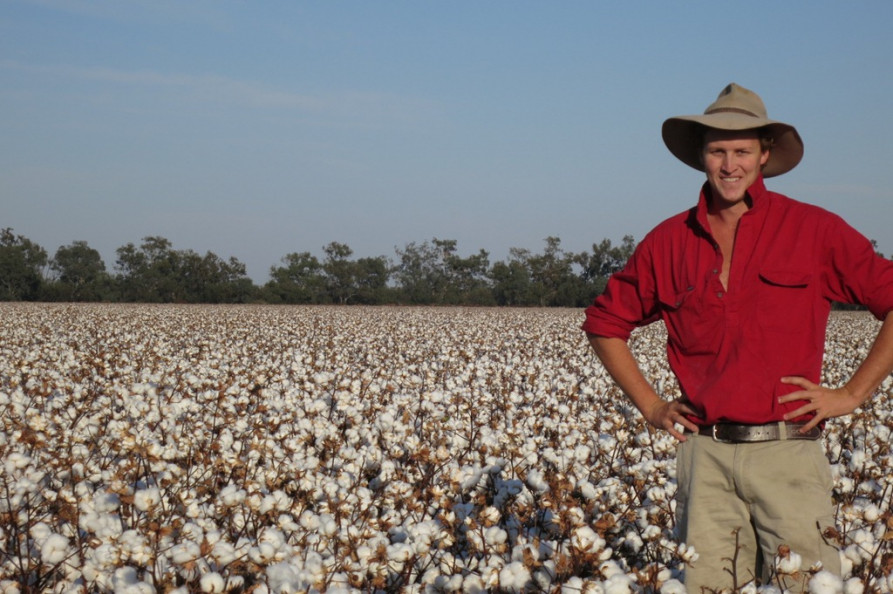This article is sponsored by Monsanto and Cotton Seed Distributors.
Acres of Opportunity for cotton growers
GROWERS are continuing to see the benefits of cotton with the introduction of the latest high yielding, high quality varieties, combined with improvements in crop management and technology.
These factors are all making cotton easier to grow and facilitating expansion into newer production areas.
The introduction of Bollgard® 3 technology last season is also a significant step forward for the industry in the battle against insect pests and the subsequent reduction in pesticide use across the entire industry.
Bollgard® 3 has provided broader planting windows, reduced refuge areas and more flexible end of season pupae busting requirements making the crop more attractive to both irrigated and dryland growers than ever before.

Monsanto and CSD staff with the first bag of Bollgard® 3 cotton, at CSD’s facilities at Wee Waa.
To assist new growers Monsanto and Cotton Seed Distributors (CSD) have collaborated to develop a new grower web resource, Acres of Opportunity.
The online platform provides growers with up to date information on growing cotton and offers valuable support for new growers.
Water woes
After a long history of uncertainty and variability in water allocations, irrigated cotton growers in the Lachlan valley are forecasting the largest cotton crop on record this season.
Approximately 18,000 hectares of cotton are expected to be grown in the region, with an increase in the number of growers trying cotton for the first time.

Australia's fourth-longest river, the Lachlan is known for its role in the production of fruit, vegetable and broadacre crops, but with water security challenges, economic growth in the agriculture sector has been limited.
During the millennium drought, the Lachlan valley was one of the worst affected areas in eastern Australia, with the irrigated cotton area falling as low as 2,000 hectares in 2008, due to lack of water availability.
However, flooding events in 2010 and 2016, along with continued favourable seasons, have dramatically improved water security and allocations for local irrigators.
The flood event in October and November 2016 provided some hope for downstream growers, although for many, the excess floodwater arrived too late to capitalise on, as the focus had shifted to keeping the water out.
Irrigators sold on the future of cotton

This season, the Lachlan valley’s main water storage, Wyangala Dam is estimated at 85 per cent capacity, a level not seen since 2010.
Minor storages are also at higher than average capacities, with Carcoar Dam at 91pc, Lake Cargelligo at 96pc and Lake Brewster at 50pc significantly contributing to allocations.
It’s good news for irrigators, who have been provided with a 108pc allocation of general security entitlements, most of which is being carried over from last season.
Such a large upfront allocation combined with the use of groundwater in some areas has the Lachlan valley shaping up for its biggest year ever when it comes to cotton.
Before this season, 2011 was the Lachlan’s highest ever cotton plant at 16,800 green hectares (see Figure 1).

Figure 1. Lachlan valley historical green hectare cotton plantings
Since this time, cotton plantings have fluctuated based on allocations, although 2017-18 is by far the greatest opportunity growers have had since the millennium drought.
With such favourable allocations this season, the valley will see a record number of new, first time, cotton growers join the industry.
It is estimated that there will be at least 40 growers contributing to this season’s crop with cotton being planted across more than 50 farms in total.
The recent dry conditions have been tough for winter crops across the region, but the unusually long dry spell has provided ample opportunity for growers to prepare more ground for the coming summer crop with the certainty of water availability, allowing them to finance and market the crop in advance.

Cotton is the predominant summer crop this season, due to its stand-out potential profitability and return per megalitre of water.
The Lachlan valley provides an ideal climate for cotton, with hot summer temperatures providing the crop with a long growing season and sufficient time to reach cut-out for desired boll maturation, ensuring optimal yield and fibre quality.
It’s expected that the greatest growth regions along the Lachlan will be in the Condobolin and Forbes areas, due to an increase in the number of irrigators making the decision to grow cotton for the first time.
Hillston has traditionally been the primary area of cotton production but with the majority of first time growers being upstream of Hillston, word seems to be spreading.

CSD Extension and Development Agronomist, Rob Eveleigh marks out a bale picked from one of CSD’s research trials.
It’s estimated that growers will be budgeting on a minimum of 10 bales to the hectare when deciding on crop inputs, and with cotton pricing hovering around $500/bale, the crop offers exceptional gross margins.
Cotton seed is also a significant contributor to profits, as a byproduct of the cotton ginning process.
Once the lint and fibres have been removed from the cotton seed, the remaining product is a highly digestible source of protein, a popular stock feed for sheep and cattle.
With recent dry conditions pushing up grain prices, cotton seed is also attracting good prices of around $300 per tonne into feedlot and dairy markets in southern NSW.
This article is sponsored by Monsanto and Cotton Seed Distributors.
Πηγή: theland.com.au

